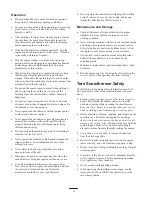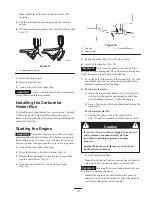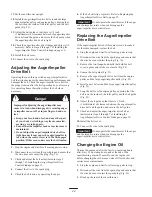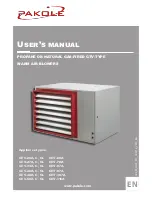
13
Danger
When fueling, under certain circumstances, a
static charge can develop, igniting the gasoline. A
fire or explosion from gasoline can burn you and
others and damage property.
•
Always place gasoline containers on the ground
and away from your vehicle before filling.
•
Do not fill gasoline containers inside a vehicle or
on a truck or trailer bed because interior
carpets or plastic truck bed liners may insulate
the container and slow the loss of any static
charge.
•
When practical, remove gasoline-powered
equipment from the truck or trailer and refuel
the equipment with its wheels on the ground.
•
If this is not possible, then refuel such
equipment on a truck or trailer from a portable
container, not from a gasoline dispenser nozzle.
•
If you must use a gasoline dispenser nozzle, keep
the nozzle in contact with the rim of the fuel
tank or container opening at all times until
fueling is complete.
Use a fuel stabilizer/conditioner regularly during operation
and storage. A stabilizer/conditioner cleans the engine
during operation and prevents gum-like varnish deposits
from forming in the engine during periods of storage.
Important
Do not use fuel additives other than a fuel
stabilizer/conditioner. Do not use fuel stabilizers with an
alcohol base such as ethanol, methanol, or isopropanol.
1. Clean around the fuel tank cap (Fig. 12).
2. Remove the fuel tank cap.
3. Fill the fuel tank with unleaded to within 1/4 to 1/2 inch
(6 to 13 millimeters) from the top of the tank. Do not
fill into the filler neck.
Important
Do not fill the fuel tank more than 1/4 inch
(6 millimeters) from the top of the tank because the
gasoline must have room to expand.
4. Install the fuel tank cap and wipe up any spilled
gasoline.
Checking the Tire Pressure
Check the pressure of the tires because they are
overinflated at the factory for shipping. Reduce the
pressure equally in both tires to between 12 and 15 psi
(82 and 103 kPa).
Reviewing the Maintenance
Schedule
Review the Recommended Maintenance Schedule on
page 17. You may need to perform one or more additional
procedures before or soon after you begin operating the
snowthrower.
Operation
Note: Determine the left and right sides of the machine
from the normal operating position.
Operating Controls
•
Auger/Impeller Drive Control Lever (Fig. 13)—To
engage both the auger and impeller, press the lever
against the right handgrip. To disengage, release the
lever.
879
1
2
3
4
6
5
Figure 13
1.
Auger/impeller drive
control lever
2.
Traction control lever
3.
Speed selector
4.
Discharge chute control
5.
Chute deflector handle
6.
Fuel shutoff valve
•
Traction Control Lever (Fig. 13)—To engage the
traction (wheel drive), press the lever against the left
handgrip. To stop the traction, release the lever.
•
Speed Selector (Fig. 13)—This control has four
positions: three forward speeds and one reverse. To
change speeds, move the speed selector to the desired
position. The lever locks in a notch at each speed
selection.
Note: Before shifting gears into or out of reverse, you
must release the traction control lever. You may shift
between any of the forward speeds without releasing the
traction control lever.
•
Discharge Chute Control (Fig. 13)—Rotate the
discharge chute control clockwise to move the
discharge chute to the left; counterclockwise to move
the chute to the right.
Summary of Contents for 38064
Page 27: ...27 ...














































